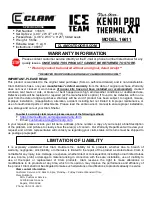
3
SV 34B User Manual
1.
INTRODUCTION
1.1. Calibration
Calibration determines the ratio between the input signal value and the indication on the display
of the measuring device (or measured result).
In principle, there are more or less large systematic deviations between the displayed
measured value and the true value of the measured signal for every measuring device. The
task of calibration is to determine these systematic deviations.
The simplest way to consider such systematic deviations is a correction of measurements by
calibration factor obtained with the use of an acoustic calibrator.
However, in many cases it is sufficient to determine that the systematic deviations are within
certain limits.
"Correct" value of the measured signal is set before calibration, and this value is compared
with a value measured by the measuring device.
Thus, calibration means establishing a relationship between the reference and measured value
of the variable for the corresponding standard to be able to take this ratio into account in
subsequent measurements as a correction factor (calibration factor).
1.2. Accuracy of calibration
Measuring equipment and measurement methods have deviations. The measured variable is
affected by environmental conditions (temperature and humidity), as well as the operator's
actions. The displayed value of the measured variable will therefore usually deviate from the
true value of the measured variable.
It is recommended to check the SV 34B every 2 years with periodic testing of the test
equipment to ensure that the level values do not change, and the test results are reliable.
It is important to carefully check who should perform such monitoring:
- internally by the monitoring body,
- SVANTEK's own calibration laboratory according to ILAC,
- externally from PTB = Physikalisch-Technische Bundesanstalt or
- another local accredited laboratory.
Accuracy
There is a deviation between the true value and the average value of the series of
measurements under repetitive conditions, which is the result of repeated measurement of the
reference level.
Overview of the classification of sound level meters and calibrators
Classification of sound level meters and acoustic calibrators
The acoustic calibrators (see IEC 60942. 2003) and the sound level meters (see IEC 61672:
2002) are classified into their respective classes and types for accuracy.




























